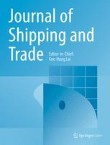The Journal of Shipping and Trade is affiliated with the Shipping Research Centre at the Hong Kong Polytechnic University.
A terminal level analysis of service quality at Nigerian seaports
Seaport terminals are major facilitators of international trade. One issue that is very crucial to the performance and survival of seaport terminals is the quality of service provided. However, in order to enh...
